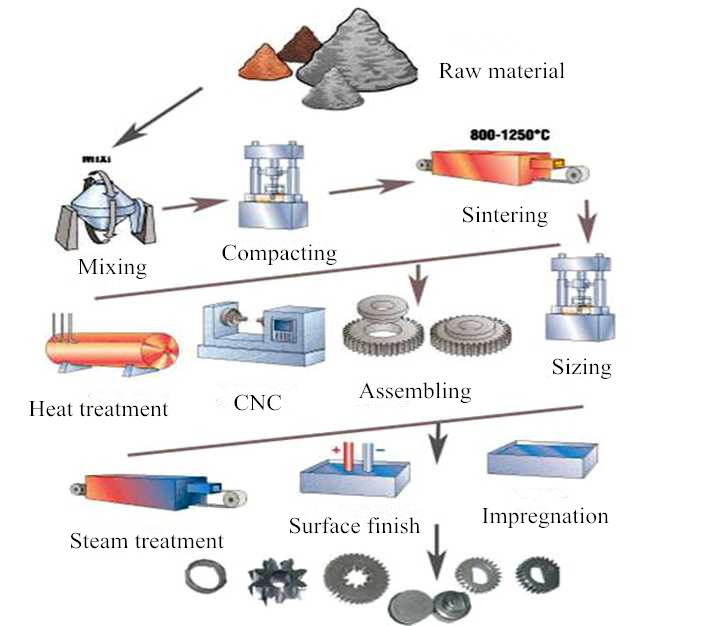For Complex three-dimensional geometric shapes Metal Parts
MIM process can achieve annual production from thousands to millions, but since MIM process requires the use of molds, MIM process is usually not used for parts with small production. Generally speaking, MIM process has more advantages for products with annual production of 20,000 or more, while for products with annual production below 20,000, the investment of mold cost needs to be evaluated. Powder injection molding is a process of filling the raw material into a mold similar to plastic products by an injection molding machine, so it can design complex shapes like traditional plastic products. When the parts have holes, grooves, ribs, bosses and other obvious features, MIM process becomes more valuable.
Why Powder Metal Metallurgy?
The powder metal metallurgy process provides a host of advantages over competing metalworking technologies. These all add up to part-to-part uniformity for improved product quality, shape and material flexibility, application versatility, and cost effectiveness.

Metal injection molding (MIM) has become an important part of powder metallurgy and has steadily grown in recent years. MIM can automatically and in large quantities produce small precision-sized, three-dimensional complex components. This process greatly reduces the complex procedures and costs of traditional metal processing, making it competitive in certain industrial applications. MIM is now widely used in the fields of machinery, electronics, automobiles, clocks, optoelectronics, weapons, medical devices, and more.
Is the metal melted in mould during the injection process for the MIM parts?
No. During injection process, only the binder is melted in order to make the metal powders to flow like liquid material. Upon cooling the binders solidify giving the part strength for handling which is called 'Green part'. And green part must be subsequently sintered which can get high density and required mechanical properties. We call it 'Brwon part'.
What is the difference between MIM process and Conventional PM parts process?
3. What is the difference between MIM process and Conventional PM parts process?
Conventional PM uses high, uniaxially applied pressure to coarse metal powders in a die set to produce moderately complex components. Typically, no further densification is gained during the sintering process. Densities achieved by this method are typically in the range of 80-90% of theoretical which limit the physical properties that can be achieved for the given alloy. MIM parts are not limited in shape complexity due to the flexibility of the injection molding process. The fine metal powders used - combine with higher sintering temperatures to allow MIM to achieve near full density in the final article approximately near to 99%. It allows MIM parts to have similar properties as given alloy.
Will the metal injection molding parts shrink during removal of binders?
4. Will the metal injection molding parts shrink during removal of binders?
No, the size of metal injection parts will be not changed in the debinding process. However, in order to achieve near full density, the part will undergo a size change of up to 20% in sintering process.
Why are powder metallurgy parts generally smaller?
The most important feature of powder metallurgy products is the hardness, and when the hardness is too big, the toughness of the material is not enough. If the size of the part is very large, it needs to have strong toughness and tensile strength, which is a disadvantage that brittle materials do not have, so sintered molded powder metallurgy parts or tools are not large.
Is powder metallurgy environmentally friendly?
The powder metallurgy process is environmentally friendly. It is widely recognized as a green and sustainable manufacturing technology. The production of powder metallurgy parts involves minimal waste generation, low energy consumption, and reduced emissions compared to traditional manufacturing processes. Additionally, the use of recycled materials and the ability to create near-net shape parts contribute to resource conservation. Overall, powder metallurgy is considered an environmentally friendly process.
Advantages of the Powder Metal Metallurgy Process
Minimizes machining by producing parts at, or close to, final dimensions
Minimizes scrap losses by typically using more than 97% of the starting raw material in the finished part
Permits a wide variety of alloy systems
Produces good surface finish
Provides materials which may be heat treated for increased strength or increased wear resistance
Provides controlled porosity for self-lubrication or filtration
Facilitates manufacture of complex or unique shapes which would be impractical or impossible with other metalworking processes
Is suited to moderate- to high-volume component production requirements
Offers long-term performance reliability in critical applications
Is cost effective
HRBER METAL,ONE-STOP PRECISION POWDER METAL METALLURGY MANUFACTURER IN CHINA
Over 10 years of manufacturing experience in industries ranging from medical equipment, marine electronics, automotive components and beyond.











